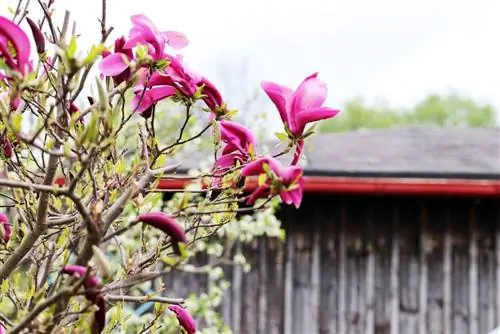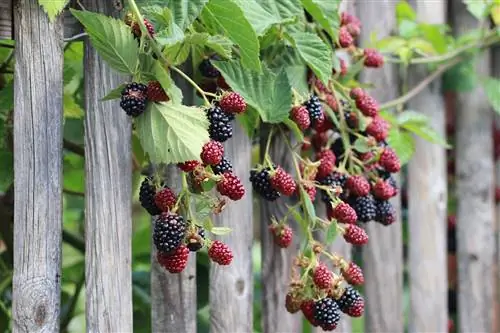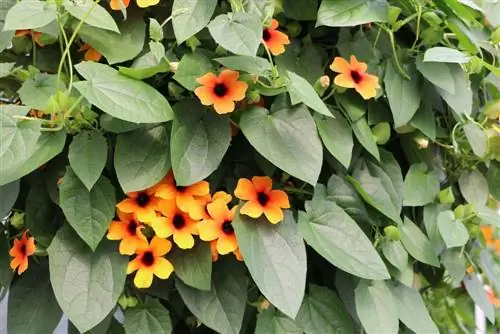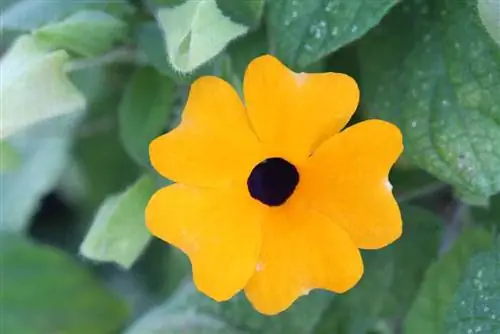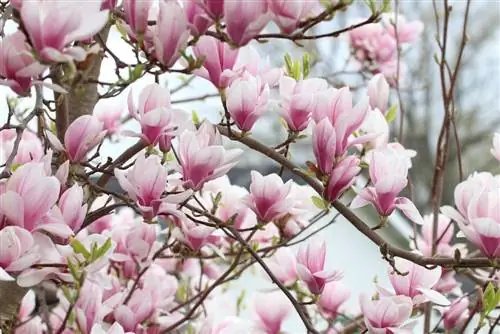- Author admin [email protected].
- Public 2023-12-17 03:39.
- Last modified 2025-01-24 12:45.
The purple magnolia 'Susan' is one of the most popular types of magnolia trees in home gardens because of its purple flowers. Whether cultivated in the front garden, as a solitary plant in a garden meadow or in a pot due to lack of space, the Magnolia liliiflora cuts a fine figure everywhere. However, it requires a little care if the summer-green shrub or tree is to remain beautiful for a long time.
Purple Magnolia Care
The purple magnolia is characterized by its beautiful flower color. The deciduous tree or shrub requires the same care as all magnolia trees. However, the graceful plant is also often cultivated in a pot and can therefore find a place next to or on a terrace; it is usually too big for the balcony, even in a pot. A front garden is also enhanced by Magnolia liliiflora. With the right care, magnolias grow very old and will delight their owner for many years.
Location
Magnolias like to be planted as solitary plants. The tree should have enough space all around. Since the crown can become very expansive, at least four square meters should be allowed around it, even for smaller varieties such as Magnolia liliiflora. Otherwise the location should be chosen as follows:
- protected from easterly winds
- otherwise the flowers will be lost
- ideal in front of a house wall or in a corner of a building
- in milder climates also free in a meadow
- bright and full sun to partial shade
- at least four hours daily, preferably more, sun
- in a bucket on a protected terrace or balcony
Plants outdoors
The ideal planting time for the purple magnolia 'Susan', which is usually sold in bales, is autumn and early spring before budding. But especially if a cold and frosty winter is imminent, planting should be postponed until spring if the magnolia tree is to be cultivated outdoors. Then it can grow over the year and become strong enough for the coming winter. When planting, proceed as follows:
- dig a big hole
- approximately twice the size of the bale
- Create drainage to prevent waterlogging
- Spread stones or gravel on the bottom of the hole
- Pour water in hole
- Removing old soil from root balls
- Insert magnolia tree
- enter prepared soil
- Tamp down the soil well and water again
So that the purple magnolia can root well, it should be watered heavily for the first few days.
Tip:
If a magnolia tree is to be purchased, then this should be done exactly when there is time for planting. The plant should not be left without soil for longer than necessary. If the magnolia was purchased in the fall and is not going into the garden until spring, it is a good idea to put it in a pot with fresh soil for the winter and protect it from too much frost.
Plants in pots
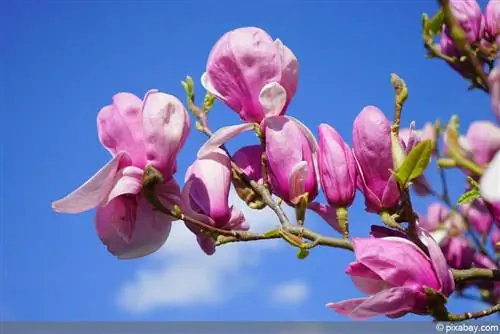
Purple magnolias are well suited to cultivation in containers. If you don't have space in the garden, you can also place a Magnolia liliiflora on the terrace or a larger balcony. The bucket should always be twice as big as the ball of the magnolia you purchased. When planting, proceed as follows:
- Create drainage to prevent waterlogging
- Gravel or pottery shards over the drain hole
- place plant fleece over this
- fill in some of the prepared soil
- water well
- Removing soil from bales
- Insert trees
- fill in the remaining soil and press down well
- water well again
- empty the collecting plate after a while
Tip:
If the magnolia tree is planted in the pot in autumn, it should be moved directly to a bright and cool, frost-free place and only find its location on the terrace, balcony or in the front garden next spring.
Substrate & Soil
The soil is humus, slightly acidic and evenly moist. It is ideal if sand is added to the soil, as this makes the magnolias more frost hardy. Moist clay soils, on the other hand, freeze more quickly, so sand should always be mixed into the soil. Waterlogging must also be avoided. Before the first planting, the soil at the location in the garden should be prepared as follows:
- Fix compost
- Peat for pH
- Sand for permeability
The soil should be mixed accordingly a few weeks before planting, then the minerals in the compost can develop their full effect through microorganisms in the soil, and the soil is then optimally supplied with nutrients when the young tree is planted.
Tip:
Special rhododendron or azalea soil is suitable for plants grown in pots, as it is already slightly acidic and permeable.
Fertilize
Since the root system of magnolia trees runs very superficially directly below the surface of the earth, fertilizer should not be incorporated into the soil. The tree reacts very sensitively to any kind of soil cultivation. Therefore, you should not work with a rake around the purple magnolia. The magnolias should be fertilized as follows:
- Sprinkle horn shavings
- use organic complete fertilizer
- enrich the soil with compost before planting
- fertilize only twice a year
- once in spring before budding
- in autumn to strengthen resistance to the cold
- cultivated in a bucket should be fertilized every two weeks
Tip:
Purple magnolias that have been cultivated in a container can also be regularly supplied with liquid fertilizer. It is important that it should not contain any lime and that its active ingredients keep the soil slightly acidic. Fertilizer is also suitable for azaleas or rhododendrons.
Pouring
Magnolias need a lot of moisture, although waterlogging should be avoided at all costs. Naturally falling rain is usually sufficient here. It only needs to be watered during very hot periods in summer. You should proceed as follows:
- if the soil is dry, give water
- only water in the early morning or late evening hours
- Magnolias do not tolerate lime
- so water with collected rainwater
- alternatively use filtered tap water
- cover the ground with bark mulch in summer
- retains moisture in the soil
Cutting
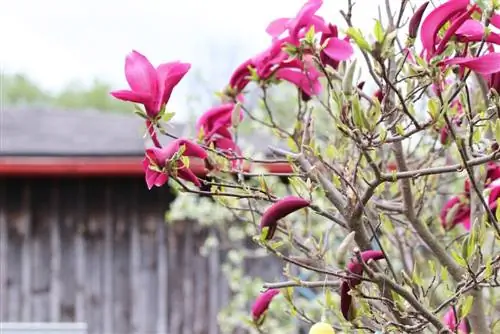
Purple magnolias, like all magnolia species, do not like to be cut. The most beautiful growth is always achieved when the tree or shrub is allowed to grow unhindered. But every now and then a small or larger cut still needs to be made, for example if the Magnolia liliiflora becomes too large or has been damaged by a storm. You should then proceed as follows:
- use only disinfected and sharp tools
- Pruning saw and secateurs are enough
- prune immediately after flowering
- remove all sick and dead shoots
- Remove competing shoots for the main trunk
- These are steeply growing shoots
- Just thin out the crown
- cut off shoots growing crosswise and inwards
- Remove branches that have been snapped by the storm
- cover larger cut surfaces with tree wax
Propagate
If you own a purple magnolia 'Susan', you might want even more of the graceful trees. An existing magnolia can easily be propagated by lowering it. The procedure is as follows:
- select one or more shoots
- this should not be too woody
- must be long enough to reach the floor
- loose up the soil next to the tree and enrich it with compost
- draw a furrow about 20 cm long
- A spade can be used for this
- Remove flowers and leaves from sinkers
- Make three to four chinks with a sharp, cleaned knife
- Put the sinker in the furrow
- anchor with tent peg or curved long nail
The tip of the sinker still needs to be seen. Pour in moderately and keep moist for a while. After a few weeks, the shoot develops its own roots, but continues to be nourished by the mother plant. When the roots have developed strongly, the sinker can be cut straight with a sharp knife or scissors and planted in its new location, whether in a container or outdoors.
Tip:
Lowering is ideally carried out in spring so that the offshoot can develop well over the summer and into autumn. In winter, the new purple magnolia 'Susan' needs to be well protected from frost and cold. It is therefore advisable to place the young plant in a pot in the first year, even if it is later to be placed outdoors.
Repotting
Potted plants should be repotted regularly. Not only because they need a larger pot, repotting is also necessary for a fresh substrate. If the purple magnolia 'Susan' becomes too large in the pot, you should choose a larger container. Since these are shallow-rooted plants, it is important that the pot is wide; the height is not important. The pot is then prepared as described under “Plants in the pot” and the plant is inserted. A little caution is required when removing the magnolia tree from the old pot. Ideally, two people work here. This way one person can hold the pot while the other removes the tree.
Tip:
The ideal time for repotting is spring before the new flowers emerge.
Wintering
Young magnolia trees are only partially hardy and should therefore receive winter protection. There is nothing to worry about with older purple magnolias if they are cultivated outdoors. Potted plants, on the other hand, should always receive winter protection, as the roots could freeze more quickly in the little soil.
Overwintering outdoors
Before the first frost arrives, action must be taken. For this purpose, the ground around the magnolia tree is given a layer of mulch, which consists of bark mulch, leaves and foliage. A layer of brushwood and straw can then be added over this. The tree itself is protected as follows:
- wrap the trunk with plant fleece
- also the crown
- make sure that there are no vacancies
- protect from too much sun
- remove protection from flowering in spring
- Observe the weather and protect yourself if necessary
The flowers in particular can be significantly damaged by a late night frost. So the all-clear is only given for mid-May after the Ice Saints.
Overwintering in a bucket
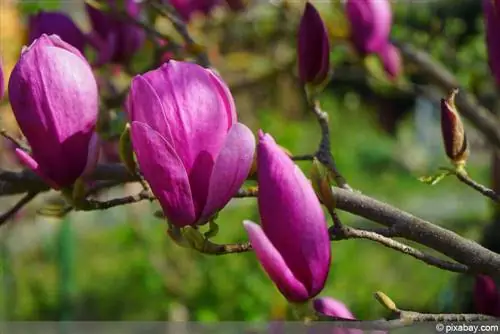
If there is a sheltered place on the terrace or balcony, then this is ideal for overwintering the potted plants. The location should be directly next to a wall or in the corner of a terrace. Otherwise, the winter protection for the magnolia in the pot looks like this:
- Place the bucket on Styrofoam or wood
- wrap with brushwood mats or plant fleece
- lay mulch or brushwood mats on the soil
- young plant also protect the crown and trunk
- wrap these with plant fleece
With older plants, only the pot needs to be protected from the cold; the crown can remain open even in winter. It is important that the location is protected from wind and snow.
Tip:
If a bright and cool winter quarters are available, for example a bright, frost-free garden house or an unheated winter garden, then this is the ideal winter location for the purple magnolia 'Susan'
Care errors, diseases or pests
As a rule, only weakened magnolias are attacked by diseases or pests. Therefore, these are primarily care errors that can be corrected. An incorrect location or incorrect care can lead to the following diseases or pest infestations:
- Leaf spot disease
- in humid, warm weather
- remove all affected shoots
- Mildew
- fight with fungicides
- Use garlic broth as a home remedy
- remove infected shoots
- Scale insects
- whitefly
- Aphids
- proceed with insecticides
The roots are often also attacked, for example by voles. To combat this, it helps to create a vole screen when planting if the plant was cultivated outdoors. Nematodes from well-stocked garden shops can help against black weevils, whose larvae also damage the roots. They are simply added to the soil with the irrigation water.

